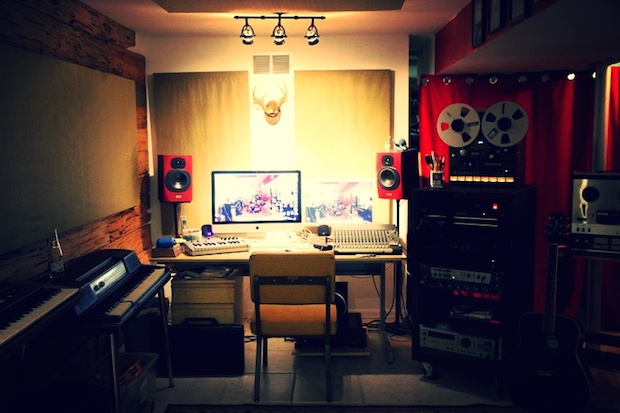 Recording studio in Brooklyn, NY (image via blog.sparkplug.it)
Recording studio in Brooklyn, NY (image via blog.sparkplug.it)
This article originally appeared on the Sparkplug blog.
Space is at a premium in New York City (and LA, and Seattle, and Boston), but you probably already knew that. Many musicians are skipping the process of booking studio time and are building home studios, but you probably already knew that, too. A typical NYC studio apartment comes with somewhere around 550 square feet of space (and fairly hefty rent, of course), leaving very little space for your Fender Bandmaster, that Ampeg SVT 8x10, and that awesome collection of guitars, mics, and preamps you’ve accumulated throughout the years.
Efficiency is the name of the game when working in the confined space of a New York apartment. Ideally, given the opportunity, most recording musicians would prefer as many options as possible when it comes to instruments, microphones, preamps, and, of course, recording space (like the room at South Brooklyn Sound, which I’m pretty sure is way bigger than my whole apartment).
Nonetheless, when life gives you lemons, you make lemonade (even if you need to go to the coffee place at the corner for some elbow room to actually make the lemonade). Here are ways you can save space while getting the job done and getting some great sounds!
1. Use multitaskers
A great way to keep your setup lean and mean is to opt for gear that can do multiple jobs in the studio. Microphones are a great example: I prefer a pair of small diaphragm condenser mics when recording acoustic guitar and prefer a large diaphragm mic for vocals (I like to reach for a Neumann U 87 if I’m in a studio with a decent microphone locker).
Instead of collecting different mics for every different job, check out multi-directional and even USB microphones. AKG’s P420 is a solid, affordable, all-around option. USB microphones are great space savers – the Apogee MiC is an easy plug-and-play option, while Blue’s Yeti Pro is great for virtually everything, can record in stereo, and works via XLR or USB!
[9 Mics Under $500 That Sound Incredibly High-End]
2. Embrace virtual instruments, plugins, and digital preamps
It’s pretty hard to beat the sound of a real pre-war Steinway piano or an old Plexi on 10. It’s also pretty hard to capture either in your tiny apartment without knocking down some walls, losing your security deposit, or possibly even being evicted. With an endless collection of samples and virtual instruments available for your DAW, there are plenty of workable options when recording keys, drums, horns, and strings.
Native Instruments has a diverse range that is eclipsed only by independent user libraries (and many of them are free!). Just as recording real piano in your apartment may not be an option, recording a real djembe may not be an option, either (unless you have one that doubles as a coffee table). Virtual instruments can be your friend.
Same goes for guitarists: the combination of the right guitar with the right amp/microphone is tough to beat, but with Native Instruments’ Guitar Rig, the classic Line 6 Pod, or even (if you have a few extra bucks) the mighty Kemper Profiling Amplifier, you have options that sound great! Best of all, direct recording means you don’t always have to compete with outside noise (while that may be hard for vocals, maybe opt for a portable vocal booth, like an sE Electronics Reflexion Filter).
[6 of the Most Useful Free VST Instruments and Plugins]
3. Size matters
The amount of compact gear options is growing, and that’s a good thing. Whether you care about subway etiquette or just care about your lower back, traveling light is key for those of us who rely on mass transit to get to and from gigs and sessions.
Midi controllers like the M-Audio Axiom Air 32 easily fit in your backpack with your laptop, Phil Jones Bass makes amplifiers the size of briefcases, and the Tech 21 Fly Rig 5 challenges the tone of pedalboards three times its size. The best parts about these compact options, of course, is that they sound great and take up little space in your home studio.
Whether you’re a fellow city dweller, sharing your home with a few others, or are just looking to trim up your own setup, there are plenty of great gear options out there. Of course, the items and methods are only suggestions based on personal preferences and experiences. After all, it’s your recording! It’s your gig! It’s your music! Now get out there, be creative, and make some music!
Next up: How to Build an Incredibly Effective Home Studio for Under $800
Sparkplug is an online marketplace where musicians rent instruments, gear, and space to and from each other. Find us on Twitter, Instagram, and Facebook.







